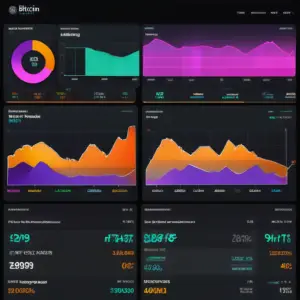
bitcoin
Introduction:
Bitcoin, the world’s first and most prominent cryptocurrency, has garnered significant attention and investment since its inception. As we look towards the future, investors and enthusiasts are eager to explore the potential trajectory of Bitcoin’s price in the year 2025. In this in-depth report, we will analyze various factors that could influence Bitcoin’s price over the next few years and present a comprehensive prediction for its value by 2025. By examining both fundamental and technical aspects, we aim to provide valuable insights for investors seeking to unlock rewarding returns in the Bitcoin market.
- Macro-Economic Factors:
a. Global Adoption and Institutional Interest: Bitcoin’s price is expected to be influenced by its increasing global adoption and acceptance as a legitimate asset class. The growing interest and investment from institutional players, such as banks, hedge funds, and major corporations, could contribute to higher demand and price appreciation. Increased institutional involvement may bring improved market liquidity, reduced volatility, and greater mainstream acceptance of Bitcoin as a store of value or medium of exchange.
b. Macroeconomic Conditions and Financial Crises: Bitcoin’s price has historically demonstrated a positive correlation with global economic instability and financial crises. In the event of economic downturns, currency devaluations, or inflationary pressures, investors may seek refuge in Bitcoin as a hedge against traditional financial markets. Factors such as government policies, central bank actions, and geopolitical events will likely play a role in shaping macroeconomic conditions and their impact on Bitcoin’s price in 2025.
- Technological Advancements:
a. Scaling Solutions and Network Upgrades: Bitcoin’s scalability has been a topic of debate and concern. However, ongoing technological advancements, such as the implementation of second-layer scaling solutions like the Lightning Network, could address the network’s capacity constraints and transaction speed limitations. These upgrades may enhance Bitcoin’s usability, reduce transaction costs, and attract increased user adoption, positively impacting its price.
b. Integration of Institutional Infrastructure: The development of robust institutional infrastructure, including regulated cryptocurrency exchanges, custodial services, and derivative products, could facilitate greater participation from institutional investors. As traditional financial institutions continue to embrace Bitcoin, the ease of access and investment options may drive higher demand and subsequently impact the price positively.
- Halving Events and Scarcity:
Bitcoin’s supply is governed by a pre-determined issuance schedule, with “halving” events occurring approximately every four years. During these events, the rate at which new Bitcoins are created is halved, reducing the supply entering the market. Historically, halving events have correlated with significant price increases, as the reduced supply and increased scarcity lead to potential upward pressure on prices. Considering the next halving event is projected to occur in 2024, its impact on Bitcoin’s price in 2025 should be taken into account.
- Regulatory Environment:
The regulatory landscape for cryptocurrencies is evolving worldwide. Clarity and favorable regulations can promote market confidence and encourage greater participation from investors and institutions. Regulatory developments that support innovation, provide legal clarity, and enhance investor protection could positively influence Bitcoin’s price by reducing uncertainty and encouraging wider adoption.
- Technical Analysis:
Technical analysis involves studying historical price patterns and market indicators to predict future price movements. Analysts use tools such as chart patterns, moving averages, and trendlines to identify potential support and resistance levels, as well as price trends. By applying technical analysis techniques to Bitcoin’s historical price data, analysts can develop price projections for 2025 based on historical patterns and trends.
Conclusion:
While predicting the precise price of Bitcoin in 2025 remains speculative, several factors suggest a potentially rewarding future for the cryptocurrency. Global adoption, institutional interest, macroeconomic conditions, technological advancements, halving events, regulatory developments, and technical analysis all contribute to the potential price trajectory of Bitcoin. Investors should consider these factors and conduct thorough research before making investment decisions.
It is essential to note that the cryptocurrency market is highly volatile and subject to numerous unpredictable factors. Investors should exercise caution, diversify their portfolios, and consult with financial professionals when making investment decisions. By staying informed, understanding the fundamental and technical aspects of Bitcoin, and evaluating the evolving market dynamics, investors can position themselves to potentially unlock rewarding returns in the Bitcoin market in 2025 and beyond.
Let’s dive into a more in-depth analysis of each factor that could influence Bitcoin’s price in 2025:
- Macro-Economic Factors:
a. Global Adoption and Institutional Interest: The increasing global adoption of Bitcoin as a recognized asset class has the potential to drive significant price appreciation. Institutional investors, including banks, hedge funds, and corporations, are increasingly allocating funds to Bitcoin. As institutional interest continues to grow, greater capital inflows into the cryptocurrency market could contribute to higher demand and price appreciation. Increased institutional participation may also bring improved market liquidity, reduced volatility, and a broader acceptance of Bitcoin as a viable investment vehicle.
b. Macroeconomic Conditions and Financial Crises: Bitcoin has historically shown a positive correlation with economic instability and financial crises. During periods of economic uncertainty, currency devaluations, or inflationary pressures, investors may turn to Bitcoin as a hedge against traditional financial markets. Geopolitical events, government policies, and central bank actions can all impact macroeconomic conditions. Any economic downturn or crisis in the global financial system could potentially drive increased adoption and demand for Bitcoin, leading to price appreciation.
- Technological Advancements:
a. Scaling Solutions and Network Upgrades: Bitcoin’s scalability has been a long-standing concern, with limitations in transaction speed and network capacity. However, ongoing technological advancements aim to address these challenges. The Lightning Network, a second-layer scaling solution, has the potential to significantly improve Bitcoin’s scalability by enabling faster and cheaper off-chain transactions. As scalability improves, Bitcoin’s usability and adoption could increase, potentially leading to higher demand and price growth.
b. Integration of Institutional Infrastructure: The development of robust institutional infrastructure is vital for wider institutional adoption of Bitcoin. The emergence of regulated cryptocurrency exchanges, custodial services, and derivative products tailored for institutional investors provides greater accessibility and ease of investment. As traditional financial institutions continue to embrace Bitcoin, the integration of institutional infrastructure may attract more institutional investors, leading to increased demand and potential price appreciation.
- Halving Events and Scarcity:
Bitcoin’s issuance schedule is governed by halving events that occur approximately every four years. During these events, the rate at which new Bitcoins are created is halved, reducing the supply entering the market. Historically, halving events have correlated with significant price increases. The reduction in supply, combined with sustained or increased demand, creates potential upward pressure on prices due to increased scarcity. The next halving event is projected to occur in 2024, and its impact on Bitcoin’s price in 2025 should be considered when predicting future price movements.
- Regulatory Environment:
The regulatory landscape surrounding cryptocurrencies is evolving globally. Regulatory clarity and favorable frameworks can instill market confidence, encourage wider adoption, and attract institutional investors. Positive regulatory developments that support innovation, provide legal clarity, and enhance investor protection can positively influence Bitcoin’s price by reducing uncertainty and facilitating mainstream adoption. Regulatory changes, both at the national and international levels, should be monitored for potential impacts on Bitcoin’s price in 2025.
- Technical Analysis:
Technical analysis involves studying historical price patterns, market indicators, and chart patterns to predict future price movements. Analysts use tools such as moving averages, trendlines, and indicators like the Relative Strength Index (RSI) or Moving Average Convergence Divergence (MACD) to identify potential support and resistance levels and determine overall price trends. By applying technical analysis techniques to Bitcoin’s historical price data, analysts can develop price projections for 2025 based on patterns and trends observed in previous market cycles.
Conclusion:
While predicting the exact price of Bitcoin in 2025 remains speculative, analyzing macroeconomic factors, technological advancements, halving events, and regulatory developments, and utilizing technical analysis can provide insights into potential price trajectories. Global adoption, institutional interest, macroeconomic conditions, technological advancements, scarcity, regulatory environments, and historical price patterns collectively shape the potential future of Bitcoin’s price. It is crucial for investors to consider these factors, conduct thorough research, and assess the evolving market dynamics before making investment decisions.
It is important to remember that the cryptocurrency market is highly volatile, and investing in Bitcoin carries risks. Investors should exercise caution, diversify their portfolios, and seek advice from financial professionals when making investment decisions. By staying informed, understanding the factors that influence Bitcoin’s price, and monitoring market trends, investors can position themselves to potentially unlock rewarding returns in the Bitcoin market in 2025 and beyond.
Pessimistic Bitcoin Value Prediction for 2025: In a pessimistic scenario, various factors could potentially limit Bitcoin’s growth and impact its value by 2025. These factors may include:
Regulatory Hurdles: Stringent regulations or unfavorable legal frameworks imposed by governments could hinder Bitcoin’s adoption and create obstacles to its widespread use. This could limit investor confidence and negatively impact the overall demand and price of Bitcoin.
Market Volatility: The cryptocurrency market is highly volatile, and it is possible that continued price volatility and market corrections could persist in the coming years. Sustained periods of market downturns and bearish sentiment may impact investor sentiment and hinder Bitcoin’s price growth.
Technological Limitations: Despite ongoing technological advancements, Bitcoin’s scalability and transaction speed challenges may persist. If these limitations are not adequately addressed, it could impede Bitcoin’s utility as a widely adopted medium of exchange and limit its price potential.
Optimistic Bitcoin Value Prediction for 2025: In an optimistic scenario, Bitcoin’s price could experience significant growth and reach new heights by 2025. Factors that may contribute to this optimistic outlook include:
Mainstream Adoption: Continued mainstream adoption of Bitcoin as a digital asset class and a store of value could drive increased demand. Institutional investors, corporations, and even governments embracing Bitcoin could bring substantial capital inflows, liquidity, and positive sentiment, resulting in higher prices.
Global Economic Uncertainty: In times of economic instability, political unrest, or currency devaluations, Bitcoin has shown potential as a hedge against traditional financial systems. If global economic conditions worsen, it could drive investors to seek refuge in Bitcoin, leading to increased demand and upward price pressure.
Technological Advancements: Ongoing improvements in Bitcoin’s underlying technology, such as scaling solutions, network upgrades, and enhanced security measures, could address previous limitations. Increased scalability, faster transaction speeds, and improved user experience may attract more users, businesses, and developers to the Bitcoin ecosystem, positively impacting its value.
Halving Events and Scarcity: The predictable halving events, reducing the rate of new Bitcoin supply, could create a supply-demand imbalance that historically has driven price appreciation. If demand continues to outpace supply, scarcity-driven dynamics may contribute to a bullish price trend.
It is important to note that these predictions are speculative and subject to various market and external factors. The actual price of Bitcoin in 2025 could fall anywhere within a wide range, influenced by the interplay of these factors and other unforeseen events that may arise. Investors should exercise caution, conduct their own research, and seek professional advice when making investment decisions related to Bitcoin or any other cryptocurrency.
note : the above article contains affiliate links and offers if you purchase any of the offers our site may receive a commission.




